This article originally appeared on the Everyday Cycles (where John purchased his RSD Sergeant with his own hard-earned money) website and is used with permission.
The Sergeant has been in RSD’s line up since 2016, occupying the niche that’s known to us as a mountain bike, the regular trail ripper for regular riders to have an irregularly fun time on. Maybe you come from a XC racing background, maybe BMX, or perhaps a recovering roadie, but chances are if you’re looking at a modern bike you’re looking at a ‘trail’ bike, something to go far on and have a grand time ripping it up while you do. Plus tires, and fatties before them, have opened up avenues to how and what we can ride, and to me this bike represents an all in one tool that shows where trail bike design can go, and provides solid reasoning for more to follow suit.

The RSD Sergeant V3 takes on the good design cues of modern MTBs (longer reach figures, lower bottom bracket heights, slacker headtube angles, steeper seat tube angles) that have gained prominence over the last five years and built upon the versatile platform the V2 offered. The V2 had a max tire width of 3.8 using 27.5 wheels, in itself remarkable for a bike that was using 148 Boost rear spacing and a 73mm threaded bottom bracket. The narrower Q-factor kept the handling similar to ‘regular’ MTB’s and insured that finding replacement parts would be a snap. However, there were snags. Chainlines were not ideal with the wider tires, causing mud and chain clearance issues. Additionally, the amount of material manipulation at the chain stays to gain tire clearance and keep chainstay length in check had design challenges. The V3 addresses that by designing the frame using Super Boost spacing. What’s that? Super Boost uses a 157mm wide rear hub and 83mm wide bottom bracket shell, typically used on downhill bikes where the width serves to give clearance for linkages and tires, provide better frame stiffness and spoke triangulation in the wheel, resulting in a stronger overall bike-as-system. With the Sergeant V3, Super Boost provides a similar gain, but here we’re looking at drive train and tire clearance in addition to keeping the amount of material manipulation to a minimum. The result is a 27.5+ bike that now has clearance for a 27.5×4 or 29×3 tire out back, a Q factor that fits between modern MTB and fat bikes, and offers an almost all in one chassis for all season riding.

The Build
The component package is a smartly comprised selection of Race Face and Shimano. Handlebars and cranks are Turbine, with the cranks using a 28t Cinch mount chainring. The stem and post are Race Face Aeffect units with a WTB Koda saddle. Shifting duties are handled by Shimano SLX trigger and derailleur on an 11-46 11 speed XT cassette being pulled by a KMC X11sl chain, and braking duties are handled by Shimano SLX stoppers on 180mm rotors front and rear. Suspension is handled by a Manitou Mattoc Comp fork, and Sun-Ringle provides the rolling duties with SRC hubs laced to Duroc 50 rims on Wheelsmith 2.0 spokes and come tubeless ready, just add valves and sealant (not included in the build), and roll on Schwalbe Nobby Nick 27.5×3.0 in their Addix Evolution Speedgrip compound. Pedals aren’t included, so plan on purchasing your preferred stompers.
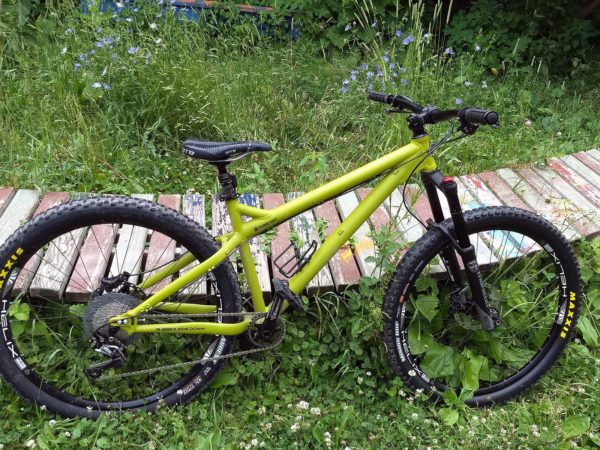

Now, I am not one who buys a stock bike. I can’t recollect the last time I purchased a complete bike, but I’d put it at some time in the mid to late 90’s. If I was to build a bike from frame up, there isn’t much I would sway from in this list, and is one of the reasons I chose this bike as a complete. I just couldn’t piece it together for the same price. Win. However, I am a tinkerer and one who doesn’t want multiple bikes that are a variation on a theme. I looked to this bike to fill two niches in my stable, a hardtail trail ripper and a beach riding, snow surfing cruiser. The stock tires were replaced by a set of 27.5×3.8 Van Helgas and a new wheelset was built for using 29×2.5 front and 2.4 rear Maxxis tires. The use of the 3.8-inch tires meant that I would need a different fork. RSD thought of this in the design process for the V3 and created a 110mm Boost spaced, 140mm corrected aluminum fork that clears the 27.5×4 tires and offers anything cage mounts on the legs. Problem solved.
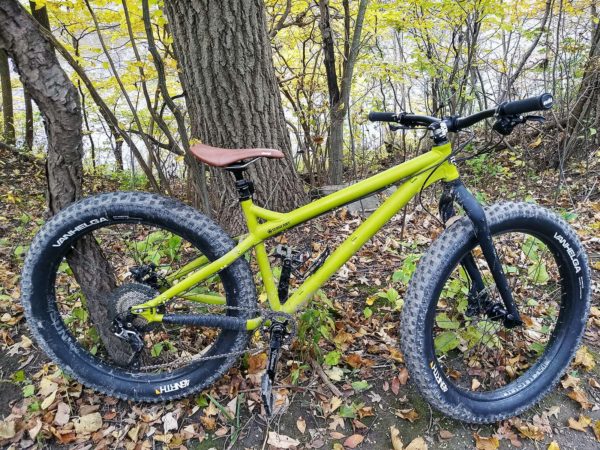
The build process is not for the mechanically challenged. Pulling the bike from the box showed that they took advantage of every precious inch the box allowed, and this necessitated having a large amount of the components packaged separately. Additionally, the stock fork’s steerer needs to be cut as do the brake lines. I suspect this is pricing control on RSD’s end and may not apply to the large and extra large sizes, but it’s worth mentioning. I highly, highly recommend getting it to your fav LBS and letting them have at it if you’ve purchased from RSD directly.
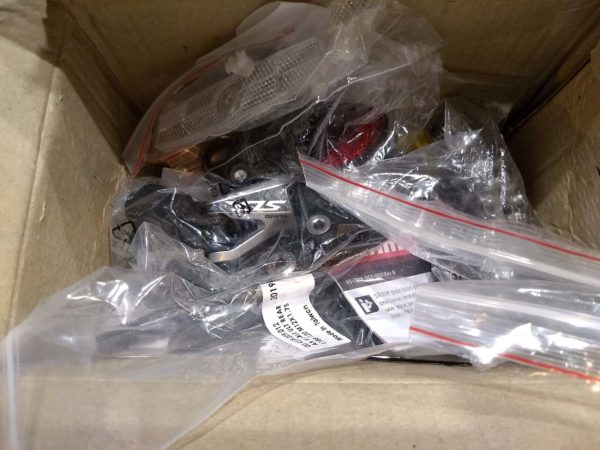
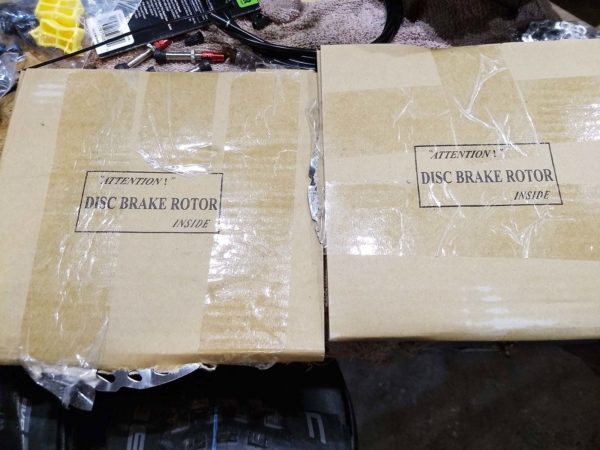

Ride Report
The geometry of the bike is modern. The 74 deg seat angle gives the feeling of being over the bottom bracket rather than behind it with the post at full extension, balancing your weight between the wheels rather than biasing towards the rear as on many older bikes. This helps climbs when you consider the 456mm reach for the medium and 66.5 deg head angle that sticks the front wheel that bit further ahead. The centered position, tight back end (445mm slammed), and slack front end put you in a position of authority over the bike. It’s not so much whispering go faster, take chances as much as it’s mocking you for not taking the jib lines on the trail’s edges. And that applies to when it’s set up in fat-bike guise as well. Acceleration is quick on the go due to the aluminum frame, and while the stays are heavily manipulated it does provide a bit of a jarring ride if you’re coming from a steel hardtail or full susser. But adapting to the feel isn’t a terrible job when a bike handles this well. The frame has rack mounts as well, adding versatility to the overall package.
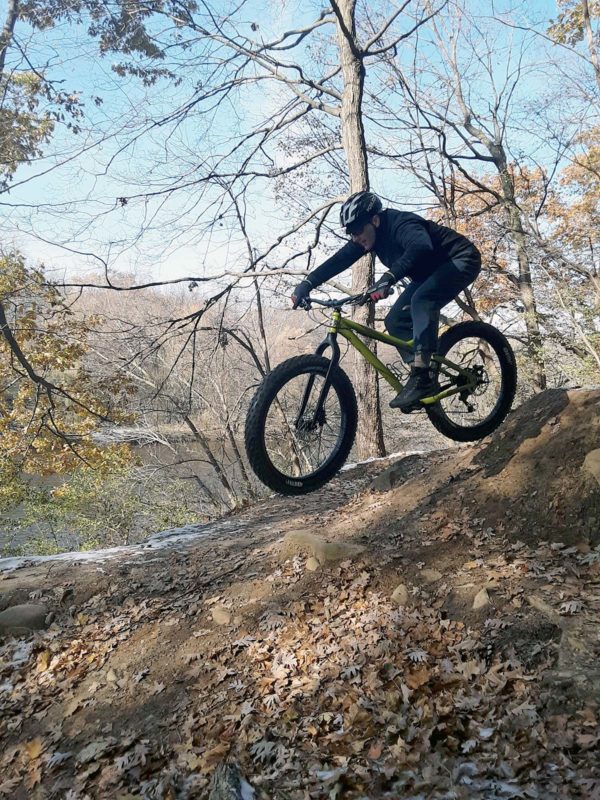
I flipped two spacers on the forks IVA top cap to get more linear midstroke feel from the fork while still allowing a good bit of ramp to prevent harsh bottoming. The ABS+ compression damper was set three positions from open for the test time with exception to roadway and doubletrack jaunts. Of note, this damper isn’t tuned to provide a firm lockout platform when full closed. The damper’s compression changes are subtle in a parking lot test when flipping between the nine available positions, with a slight firm feel in full closed. However, on the trail the differences become more apparent. The slight feedback from an overly firm position will make itself known if you’re running it too firm for your weight. The fork felt controlled and with little negative brake and pedal feedback when monkeying around on the bike. It is possible to shim the damper to provide a firm lockout position should that be desired.

The wider than normal MTB, narrower than fat-bike feel is much appreciated to this reviewer. I’ve owned a few fatties in the past, and the gripe I’ve had has been due to bottom bracket width/Q factor. Designing a bike to fit 5” tires requires a wider Q factor. Duh. For me personally, this has proven an undoing. On fat bikes, long, 20+ mile rides have given me knee pain due to the bowlegged pedaling. Over the same distances on the Sergeant, I’ve yet to experience it. On all day, cross town trail-to-trail rides, my knees have felt keen, even the day after. I attribute that to the narrower Q factor, keeping my hips, knees, and feet in better alignment. Over a nine day MTB trip, it also made switching between the Sergeant and my full susser a lot more natural feeling, something appreciated on days where both bikes were put into play depending on the trails being ridden.
Detractors
Perfection is matter of subjectivity, and no bike I’ve ridden has been the illustrious unicorn of perfection. However, the quibbles are relatively minor. First one is a matter of personal preferences on the contact points. Initial rides had me squirming for a comfortable position on the WTB Koda saddle. After a few rides, I realized no angle or linear position change was going to make it happen so on went my preferred saddle. Next, the grips are big and comfy RSD branded lock on numbers, but they didn’t work for me being a bit too big for my paw feel preference. Next were the bar and stem combo. I’ve been riding bars with more backsweep for the last few years, and my wrist bones have come to appreciate them. The combination of a 35mm diameter stem and bar clamp and low sweep were just not meeting my needs and were swapped for my preferred 11deg back swept bar with a 31.8mm clamp. Again, touch points are personal, so you may well get along with the stock set up. It certainly had nothing to do with the quality of the components themselves.
Second quibble is with a cable tie on the seat stay. The top one sits a bit further outboard than I would’ve liked and occasionally would make contact with the heel of my shoe. Tucking that under in the 6 o’clock position would eliminate that issue. Admittedly, I do pedal a bit duck footed at times, which does explain the rub, but with no real corresponding rub mark on the seatstay itself it does point that it could be done a bit tidier.

Third bit is tire clearance. This is where things get a bit tricky. First, the bike is designed to be run with 27.5×3.0 tires. In that guise, there is ample clearance between the crown of the tire and the seat and chainstay bridges when the dropout is slammed forward. As I’ve been running it as a 29er, the clearance on the 2.4 Ardent on a 27mm inner width rim is rather tight with the adjustable dropout in its slammed position, specifically on the seatstay bridge. This is more prominent when set up in fat mode with the 27.5×3.8 Van Helga tires on the stock Duroc 50mm inner width rims. In that combo there’s no clearance to speak of in the slammed position, and adjusting the dropout to the longest position is a must. The tires in both configurations have room on the chainstay bridge, but the seatstay bridge holds things back. I contacted Alex from RSD about the clearance. His response was thus, “The whole point of the sliding dropout on this bike is to be able to fit different wheel sizes and move the sliders to allow them to fit accordingly. Example: 27.5×3.0 can fit fully slammed, while a 29×2.4 will require a few mm of adjustment. Not all wheel sizes will fit in the same position. As you noticed, the 3.8 need to be slammed all the way back, hence why we chose 445mm to 460mm chain stay length.”
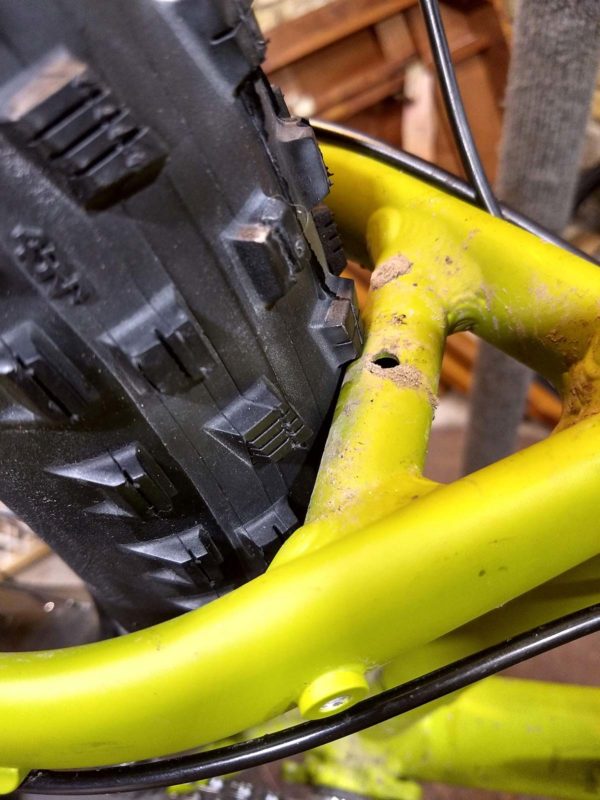
Which is a way of saying that just because it has sliding dropouts, don’t expect to be able to use them purely as a way to run the bike single speed with whatever wheel platform you run on the bike. They’re there to allow for different wheel sizes. I understand the point made, but personally I’d prefer to have the seatstay bridge moved up on the stay to gain some additional clearance. Deal breaker? Not for me, as the bike still handles remarkably well with the wheelbase stretched some, but it is worth noting.
In regards to the suspension corrected aluminum fork, the only improvement I’d like to see is the axle attachment. The axle uses a separate retaining nut to secure the wheel, basically a loose nut. Plus sides: you can set the QR axle to whichever side you prefer and should you mess up the threads you didn’t ruin the fork. I’d prefer a captured nut on the fork, but again it’s a minor quibble.
Endo
The RSD Sergeant V3 represents a new line of thinking in bike design. With far less extra coin than purchasing two dedicated bikes, you can purchase the Sergeant and the parts needed to run it as a plus size/29er trail ripper, an off road bikepacking rig, and a beach/snow taming fat bike. If you’re looking for a Swiss army knife of bikes, you’d be hard pressed to find one as adaptable, nimble, capable, and most importantly fun as the Sergeant. Like a Swiss army knife, it may not be the exact perfect tool for any one particular job, but the number of jobs it lets you work on represents a great value. This is one purchase I wholly have no regrets in making.

lighter and cheaper than the specialised fuse and with longer front fork/susp.
more versatile….great climber…awesome descender.
basically my favorite singlespeed running as a mullet setup.
after 35 years of mtb’n and having too many bikes in the past…this one is sweet for it’s versatility in how you wanna run it…i tried 29er and 27.5+…both great in their own way but the mullet setup is killing it for me.
I love my Pugsley but would love to have a bike like this where I have the option to run something skinnier in the summer and also when commuting to and from office on paved trails.
Being able to fit a Van Helga front and back should give me all the float and traction to rider 99% of my trails around Southern MI in the winter. I am definitively interested in this bike for my next purchase. Love the color too.
My dream bike!
Wish it was available in orange though.
agree with beserker above. I have ALWAYS ran steel/ti since mid ’80’s but after demoing this bike next to nukeproof and commencal and ragley and fuse etc…snapped it up. not so super slack so it really does the super tight twisties in the east coast woods in the mullet setup. almost got a banshee paradox as a more party bike but the SS dropouts on the rsd and the ability to turn faster/climb faster kept me on the sergeant.
brilliant bike. can’t believe I’m on alu but its all great with 2.6 29er butcher front and 2.8 27.5 rocket ron rear. As a straight 29er it is a great “all day” endurance racer (6 hrs. +)
Anyone try this beast out 29+?